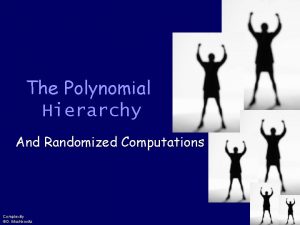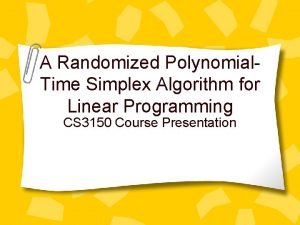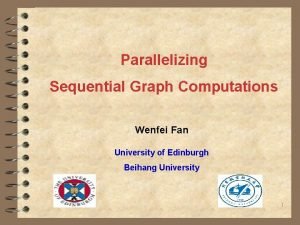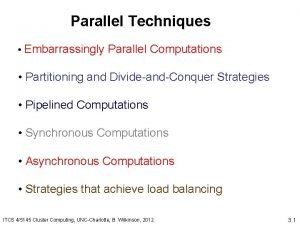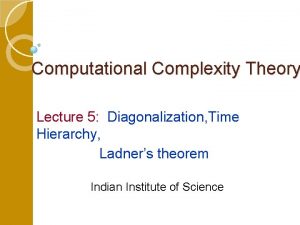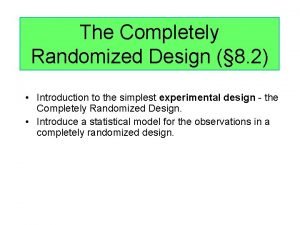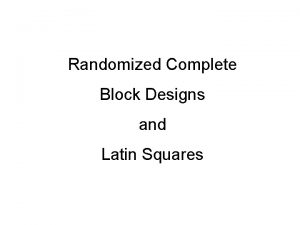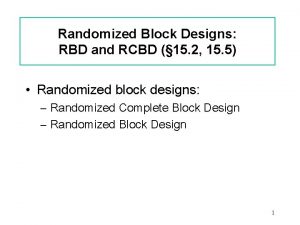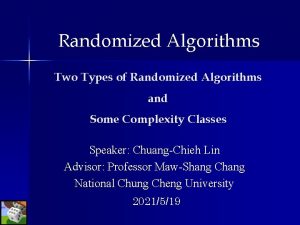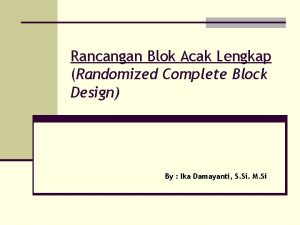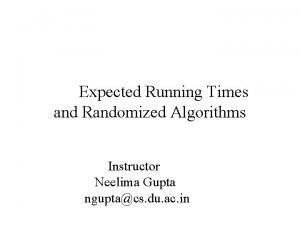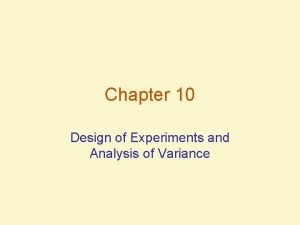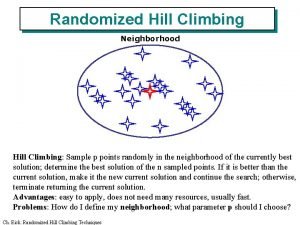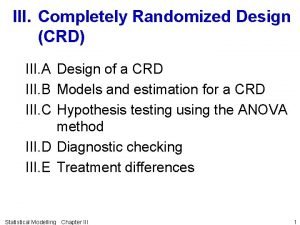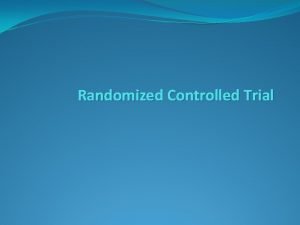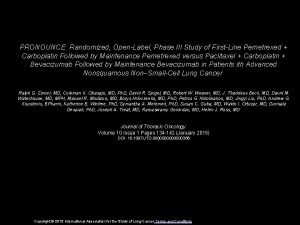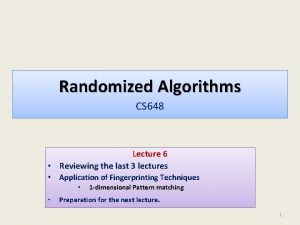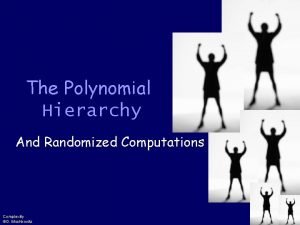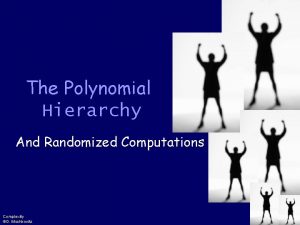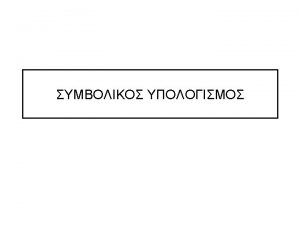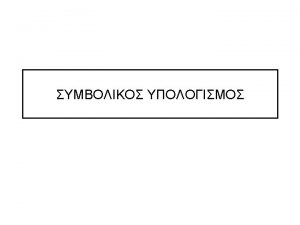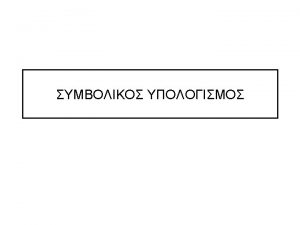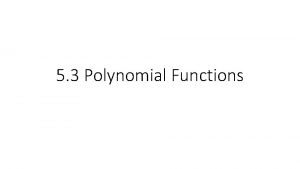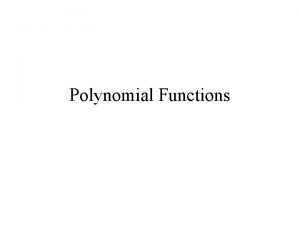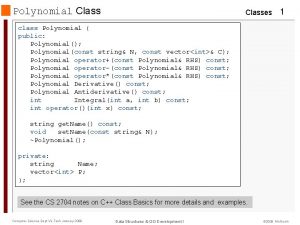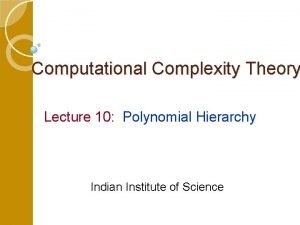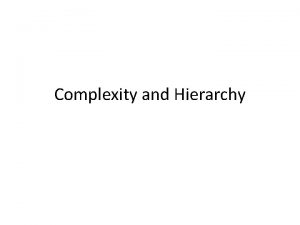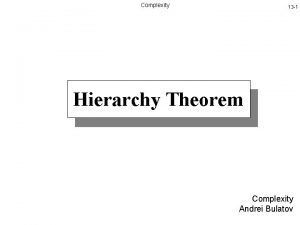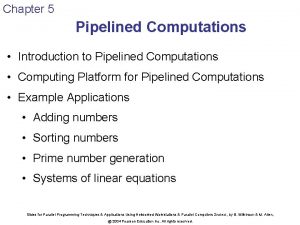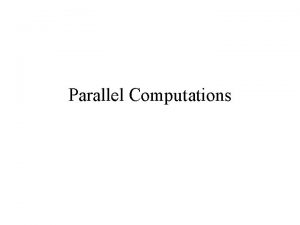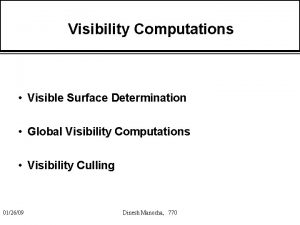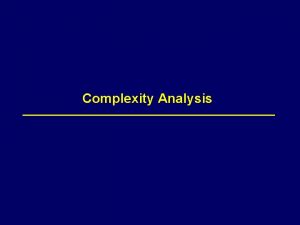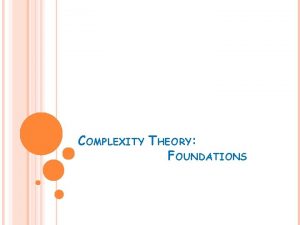The Polynomial Hierarchy And Randomized Computations Complexity D




















![Proving the Underlying Observation We will follow the Probabilistic Method Prr[r has property P] Proving the Underlying Observation We will follow the Probabilistic Method Prr[r has property P]](https://slidetodoc.com/presentation_image/2541cf62d4d11038f5a308e1077e46e2/image-21.jpg)








- Slides: 29

The Polynomial Hierarchy And Randomized Computations Complexity ©D. Moshkovitz 1

Introduction • Objectives: – To introduce the polynomial-time hierarchy (PH) – To introduce BPP – To show the relationship between the two • Overview: – satisfiability and PH – probabilistic TMs and BPP – BPP 2 Complexity ©D. Moshkovitz 2

Deciding Satifiability We’ve already seen, that deciding whether a formula is satisfiable… x 1 …xn(x 1 x 2 x 8) … ( x 6 x 3) only existential quantifier Complexity ©D. Moshkovitz x 1 x 2 x 3… [(x 1 x 2 x 8) … ( x 6 x 3)] existential & universal quantifiers 3

The Hierarchy Definition ( i): i is the class of all languages reducible to deciding the sat. of a formula of type: x 1 x 2 x 3… R(x 1, x 2, x 3, …) i alternating quantifiers Complexity ©D. Moshkovitz 4

The Hierarchy Definition ( i): i is the class of all languages reducible to deciding the sat. of a formula of type: x 1 x 2 x 3… R(x 1, x 2, x 3, …) i alternating quantifiers Complexity ©D. Moshkovitz 5

PH (Polynomial-time Hierarchy) Definition: PH = Complexity ©D. Moshkovitz i i 6

Simple Observations • “base”: 1=NP i=co i “hierarchy”: i i+1 and i i+1 “upper bound”: PH PSPACE • “connection between and ”: • • Complexity ©D. Moshkovitz 7

Can the Hierarchy Collapse? Proposition: If NP=co. NP, then PH=NP. Proof Idea: By induction on i, i=NP. Complexity ©D. Moshkovitz 8

Probabilistic Turing Machines • Probabilistic TMs have an “extra” tape: the random tape “standard” TMs M(x) content of input tape Complexity ©D. Moshkovitz probabilistic TMs Prr[M(x, r)] content of random tape 9

Does It Really Capture The Notion of Randomized Algorithms? It doesn’t matter if you toss all your coins in advance or throughout the computation… Complexity ©D. Moshkovitz 10

BPP (Bounded-Probability Polynomial-Time) Definition: BPP is the class of all languages L which have a probabilistic polynomial time TM M, s. t L(x)=1 x L x Prr[M(x, r) = L(x)] 2/3 such TMs are called ‘Atlantic City’ Complexity ©D. Moshkovitz 11

BPP Illustrated For any input x, Note: TMs which are right for most x’s (e. g for PRIMES: always say ‘NO’) are NOT acceptable! all random strings for which M is right Complexity ©D. Moshkovitz 12

Amplification Claim: If L BPP, then there exists a probabilistic polynomial TM M’, and a polynomial p(n) s. t x {0, 1}n Prr {0, 1}p(n)[M’(x, r) L(x)] < 1/(3 p(n)) We can get better amplifications, but this will suffice here. . . Complexity ©D. Moshkovitz 13

Proof Idea • Repeat – Pick r uniformly at random – Simulate M(x, r) • Output the majority answer Complexity ©D. Moshkovitz r M(x, r) 0111001 Yes 1011100 Yes 0001001 No 1100000 Yes 0010011 No 0110001 Yes 14

Relations to P and NP P ? BPP NP ignore the random input Complexity ©D. Moshkovitz 15

Does BPP NP? We may have considered saying: “Use the random string as a witness” Why is that wrong? Because non-members may be recognized as members Complexity ©D. Moshkovitz 16

“Some Comfort” Theorem (Sipser, Lautemann): BPP 2 Underlying observation: L BPP there exists a poly. probabilistic TM M, s. t for any n and x {0, 1}n there is m s. t x L s 1, …, sm {0, 1}m r {0, 1}m 1 i m. M(x, r si)=1 Make sure you understand why theorem follows Complexity ©D. Moshkovitz 17

Yes-instance {0, 1}n Complexity ©D. Moshkovitz 18

No-instance {0, 1}n Complexity ©D. Moshkovitz 19

Our Starting Point n bits • L BPP • By amplification, there’s a poly-time machine M which – uses m random coins – errs w. p < 1/3 m x m bits r M x L? false for less than 1/3 m of the r’s Complexity ©D. Moshkovitz 20
![Proving the Underlying Observation We will follow the Probabilistic Method Prrr has property P Proving the Underlying Observation We will follow the Probabilistic Method Prr[r has property P]](https://slidetodoc.com/presentation_image/2541cf62d4d11038f5a308e1077e46e2/image-21.jpg)
Proving the Underlying Observation We will follow the Probabilistic Method Prr[r has property P] > 0 r with property P Complexity ©D. Moshkovitz 21

First Direction • Let x L. • We want s 1, …, sm {0, 1}m s. t r {0, 1}m 1 i m. M(x, r si)=1 • So we’ll bound the probability over si’s that it doesn’t hold. Complexity ©D. Moshkovitz 22

Bounding The Probability Random si’s Do Not Satisfy This unionbound si’s independent r: s is random r s is random x L Complexity ©D. Moshkovitz 23

Second Direction • Let x L. • Let s 1, …, sm {0, 1}m. • We want r {0, 1}m s. t 1 i m. M(x, r si)=0 • So we’ll bound the probability over r that it doesn’t hold. Complexity ©D. Moshkovitz 24

Bounding The Probability Random r Does Not Satisfy This unionbound x L Complexity ©D. Moshkovitz 25

Q. E. D! It follows that: L BPP there’s a poly. prob. TM M, s. t for any x there is m s. t x L s 1, …, sm r 1 i m. M(x, r si)=1 Thus, L 2 BPP 2 Complexity ©D. Moshkovitz 26

Summary • We defined the polynomial-time hierarchy – Saw NP PH PSPACE – NP=co. NP PH=NP (“the hierarchy collapses”) Complexity ©D. Moshkovitz 27

Summary • We presented probabilistic TMs – We defined the complexity class BPP – We saw how to amplify randomized computations – We proved P BPP 2 Complexity ©D. Moshkovitz 28

Summary • We also presented a new paradigm for proving existence utilizing the algebraic tools of probability theory The probabilistic method Prr[r has property P] > 0 r with property P Complexity ©D. Moshkovitz 29
 Randomized polynomial time
Randomized polynomial time Randomized polynomial time
Randomized polynomial time Time and space complexity
Time and space complexity When graphs are life
When graphs are life Embarrassingly parallel computations
Embarrassingly parallel computations Diagonalization method in theory of computation
Diagonalization method in theory of computation Matplotlib inline
Matplotlib inline How to divide a polynomial by another polynomial
How to divide a polynomial by another polynomial Randomized algorithms and probabilistic analysis
Randomized algorithms and probabilistic analysis Completely randomized design
Completely randomized design Randomized skip list
Randomized skip list R o x o research design
R o x o research design Difference between rcbd and latin square design
Difference between rcbd and latin square design Advantages of rcbd
Advantages of rcbd Randomized block design spss
Randomized block design spss Types of randomized algorithms
Types of randomized algorithms Rcbd meaning in research
Rcbd meaning in research Crd design definition
Crd design definition Randomized hill climbing
Randomized hill climbing Completely randomized design vs matched pairs
Completely randomized design vs matched pairs Expected running time
Expected running time Completely randomized design
Completely randomized design Randomized hill climbing
Randomized hill climbing Contoh rancangan acak kelompok
Contoh rancangan acak kelompok Completely randomized design (crd)
Completely randomized design (crd) Factorial randomized block design
Factorial randomized block design Advantage of randomized controlled trial
Advantage of randomized controlled trial How to pronounce randomized
How to pronounce randomized Randomized algorithm in daa
Randomized algorithm in daa Anova table
Anova table
